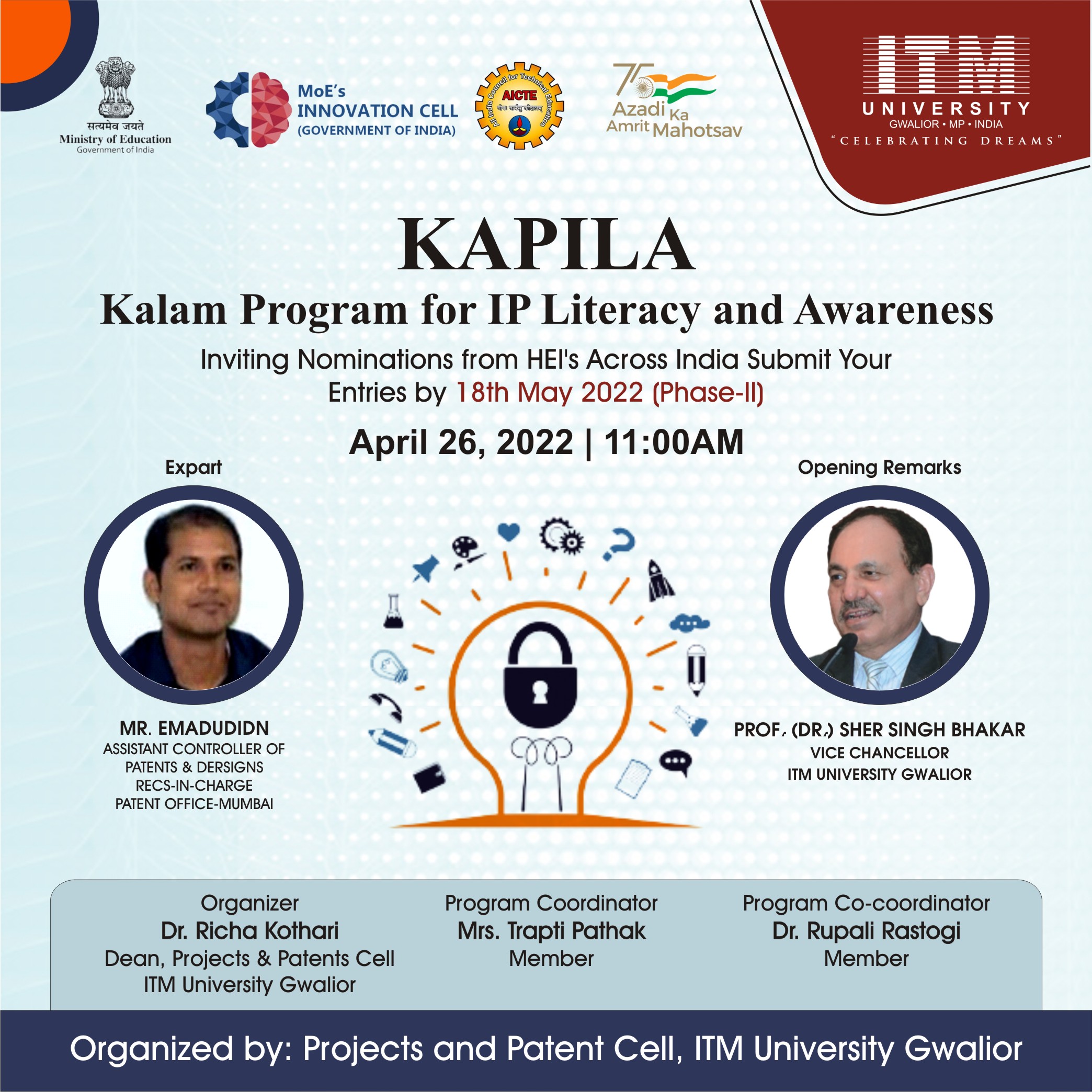Guideline on intellectual property rights
ITM University, Gwalior, over the past three decades, has consistently endeavored to train high-quality scientific and technical manpower and provide solutions to challenging technological problems through its well-qualified faculty and highly skilled supporting staff. The university aims to be a leading center of teaching, research, and extension in Engineering and Technology, committed to excellence in all its activities. ITM University fosters scholarship, research, academic excellence, and innovation. Recognizing the value of intangible assets like inventions, copyrights, designs, and creative products generated during the scientific and intellectual pursuits of its faculty and students, ITM University has formulated its intellectual property policy. This policy provides guidance to faculty, staff, students, research scholars, and external agencies on the practices and rules regarding intellectual property rights (IPR), including ownership, commercial exploitation, technology transfer, and confidentiality. The policy promotes a conducive environment for curiosity-driven and market-driven research and development activities at the University. This IPR policy serves as a guideline rather than a strict legal rule, considering the evolving nature of national IPR policies, and is subject to change as needed. This document, along with the addendum (Operating Guidelines) and services provided by the IPR Cell, offers a comprehensive overview of Intellectual Property (IP) management at ITM University, Gwalior.
Purpose of the IPR Policy
The purpose of the IPR policy of ITM University, Gwalior, is to:
- Facilitate, encourage, promote, and safeguard scientific inquiry, research pursuits, and the academic freedom of its faculty, researchers, and students.
- Create an innovative culture fostering the creation and development of IP at the University.
- Provide a clear understanding of the rights and responsibilities of faculty, staff, and students while protecting the interests of the University.
- Establish an IPR management policy and procedural guidelines for converting knowledge generated in the Institute into wealth.
- Enable the University to benefit from IP, maximizing advantages for inventors, the University, and society.
- Shape the University as a prime academic research institution practicing the highest ideals of scholarship and teaching, disseminating the benefits of IP generated at the Institute to the community and society.
Objectives
The IPR policy of ITM University aims to:
- Facilitate the protection and valorization of intellectual properties generated by its faculty, staff, and students as a result of their intellectual and scientific pursuits at the university during their employment or engagement, offering scope for wealth generation, alleviation of human suffering, and the betterment of human life.
- Promote prudent IP management practices within the University, fostering IPR awareness and culture among its faculty, staff, and students.
- Provide a comprehensive single-window reference system for all IPR-related issues.
- Create an environment for generating new knowledge through research and innovations compatible with the educational mission of the University.
Policy Statement
The University is committed to promoting, protecting, managing, and commercializing Intellectual Property in line with its primary objectives of teaching, research, and addressing community and societal needs. It supports the commercialization and exploitation of IP, providing an additional revenue source to the University while benefiting staff and students. The University recognizes traditional academic values and expectations.
Ownership of Intellectual Property
I. Patents
The University will list individuals who have directly contributed intellectual inputs as inventors or creators in all applications for intellectual property rights.
II. Copyrights
- The University owns the copyright on all teaching and instructional materials developed by employees as part of academic programs at the University. Authors retain the right to use the material in their professional work.
- Books, articles, monographs, speeches, and other communications produced by staff members during research and teaching using University resources are excluded from this clause. The University recognizes faculty ownership of copyright in such traditional works of authorship.
- For copyrightable works, including software, created with significant use of University resources, the University may demand assignment of the copyright, either in full or in part, depending on the extent of resource utilization.
- The University owns the copyright of works produced by non-institute personnel associated with or engaged in any University activity, with or without intellectual contribution from University personnel.
III. Institute-Supported Research
All intellectual property rights generated from investigations using University resources belong to the University, except in cases of joint investigations with other institutions/ agencies or under external sponsorship.
Technology Transfer
- I. The University will take necessary steps for the commercial exploitation of IPR obtained in its name or jointly with other agencies, aiming for the fullest practical extent without undue delay. Marketing of IPR will involve agreements on technology transfer, licensing (exclusive or non-exclusive), and revenue-sharing models.
- II. The University will identify potential licensee(s) for commercial exploitation of IP with absolute ownership. In cases of joint ownership, the University offers the first right to commercially exploit the joint IP, whether or not it is formally protected by patents. Licensing involves a lump sum technology transfer fee and royalty payments from the first commercial exploitation date for a mutually agreed period. If the collaborator declines, the University will commercialize the IP as it sees fit.
- III. If the collaborating organization/industry does not commercialize the IP within two years from the first development date, the University reserves the right to license the IP to a third party.
- IV. To encourage entrepreneurial activities by staff, the University may reassign its IP ownership to inventors/creators under an agreement, allowing them to market, protect, and license it independently with minimal University involvement.
- V. The University charges assignees all patenting and licensing expenses and an appropriate share of royalties, equity, or other value received by inventors/creators.
- VI. The University may exploit IP independently or commission a Technology Management Agency to bring the IP to fruition. Inventors/creators may request the University to assign rights after a specific holding period.
Revenue Sharing
Revenue from commercial exploitation of IP (technology transfer fees and royalties) is shared between inventors and the University, currently at a 60:40 ratio. If the University reassigns IP rights to inventors/creators, they must reimburse all University-incurred costs, including protection, maintenance, marketing, and associated expenses.
Application of Policy
This policy is part of employment conditions for University employees and enrolment conditions for students. The University reserves the right to amend the IPR Policy as needed. All potential creators involved in sponsored research or using University resources must comply with this policy and accept the ownership principles stated, unless an exception is approved in writing.
Right to Regulate Policy
The IPR Cell is responsible for interpreting the policy, resolving disputes, applying the policy, and recommending changes to the Chancellor through the Registrar and ViceChancellor. The Chancellor will consider recommendations and decide accordingly. The IPR policy may be reviewed after three years or sooner if significant national changes occur.
Legal Jurisdiction
All agreements signed by the University and related disputes are subject to the legal jurisdiction of the Court of Adjudicature at Gwalior and governed by appropriate Indian laws.
Intellectual Property Rights Cell (IPR Cell)
The IPR Cell formulates guidelines and policies for adoption by ITM University, Gwalior, and executes actions for their implementation. The cell ensures the speedy processing and filing of patent applications and effectively implements the University’s IPR policy and guidelines.
Structure of the IPR Cell:
- I. Convener: Nominated by the Chancellor from senior professors.
- II. Associate Professor: Nominated by the Chancellor (02)
- III. IPR Legal Advisor/Consultant: Appointed by the University, a well-known practicing attorney providing necessary advice on patent rules, regulations, MOUs, and filing of patent/copyright applications.
Responsibilities of the IPR Cell:
- IP Counseling: Interacting with inventors to identify IPR potentials.
- IP Management: Filing, maintaining, monitoring patents, and coordinating between attorneys, inventors, and University authorities.
- IP Transactions: Advising, drafting, and monitoring all IP-related MOUs.
- IP Policy Formulation: Framing and amending IP policy for University consideration.
- Promoting IP Awareness: Undertaking measures to develop an IP culture within the University.
- Capitalization of IP Assets: Recommending patentable technologies to licensing agencies, CII, and financial institutions, and marketing in-house technologies through various media.
- Assistance in Technology Transfer: Handling technology transfers developed at the University.
- Reporting on IP Assets and IPR Management: Periodically reporting to the Registrar, Vice-Chancellor, and Board of Management in the format appended towards last against its periodicity.
The IPR Cell will also:
- Appoint a panel of attorneys for processing patent applications.
- Conduct periodic patent/intellectual audits through professional experts.
- Recommend terms of payment for annuity retention fees for professional services.
- Advise on measures promoting commercialization of patents, including exhibitions and industry meetings.
- Secure protection and management of IPs in the national interest, University, and inventors.
- Seek expert advice from financial/business institutions like FICCI, CII, and IDBI. The IPR Cell reports to the Vice-Chancellor and seeks guidance from the Registrar and Vice-Chancellor in its responsibilities.
Procedure for IP Protection
All patent and copyright applications must be forwarded to the Convener, IPR Cell, through the Dean of the School/Director of the Centre, regardless of whether the inventions result from in-house or sponsored projects.
Evaluation of Patent/Copyright Applications
Disclosure Form or Copyright Disclosure Form along with an IPR facilitation request, will be received and scrutinized by the IPR Cell. The Cell may seek assistance from other professors as domain experts to preliminarily evaluate the proposals for their prima-facie patentability. These domain experts will enter into a Non-Disclosure Agreement and sign a No Conflict of Interest Form before accessing the proposal. Inventors may be requested to present their case before the IPR Cell. If the Cell recommends filing patents, the Convener, IPR Cell, will process the application through one of the approved attorneys from the panel maintained at the IPR Cell.
Can a Published or Disclosed Invention Be Patented?
No. Publication or disclosure of the invention by the inventor before filing a patent application disqualifies the invention from being patentable. Inventors should not disclose their inventions before filing a patent application. If published after filing the patent application, the number and date of the patent application should be provided to inform the public.
Exceptions for Patent
Inventions claiming substances intended for use as food or as medicine or drug or relating to substances prepared or produced by chemical processes (including alloys, optical glass, semiconductors, and inter-metallic compounds) are not patentable.
IP Counseling
The IPR Cell will counsel and interact with inventors of potential intellectual products, assisting the Institute in identifying IPR potentials. If the Cell recommends filing patents, the Convener, IPR Cell, will process the application through an approved attorney from the panel maintained at the IPR Cell. If any copyrightable work is produced during a sponsored or collaborative activity, the ownership of the copyright will be determined according to the terms and conditions specified in the contract or through mutual consultations and agreement with the sponsoring/collaborating agency.
Services from the Cell
Services can be availed by all faculty members, staff, students, research scholars (internal and external), visiting scientists, professors, and other professionals hired on a full-time or part- time basis. ITM University has established systems and mechanisms to structure the process of commercial exploitation of knowledge generated at the University under the provisions of the IPR regime in the country.
Services Provided by the IPR Cell
The IPR Cell will:
- Respond quickly and accurately to queries during the patent application process to expedite and save money.
- Periodically recommend patentable technologies to potential licensing agencies, CII, and financial institutions for venture capital investment.
- Promote IP awareness and develop an IP culture within the University.
- Provide IP counseling and assist in technology transfer.
- Submit periodic reports on IP assets and IPR management to the Registrar, ViceChancellor, and Board of Management.
- Appoint a panel of attorneys for processing patent applications.
- Conduct periodic patent/intellectual audits through professional experts.
- Recommend terms of payment for annuity retention fees for professional services.
- Advise on proactive measures promoting patent commercialization, including exhibitions and industry meetings.
- Secure protection and management of IPs in the interest of the country, University, and inventors.
- Seek expert advice from financial consultants and institutions such as FICCI, CII, and IDBI.
- Time-Bound Application Processing: The IPR Cell will adhere to a strict timeline for processing patent and copyright applications. Initial evaluation of applications will be completed within 30 days of submission. Upon recommendation for filing, patent applications will be processed and filed within an additional 30 days. Copyright applications will follow a similar timeline.
The IPR Cell will interact with faculty members, patent attorneys, financial institutions, and industries and follow up on royalty payments from industries.
Table: Reporting Progress of Intellectual Property Rights (IPR)
| Sl. No. |
Report Type |
Details |
Frequency |
Responsible Party |
| 1 |
Overview of IP Portfolio |
Summary of all IP assets including patents, copyrights, and trademarks. |
Quarterly |
IPR Cell Coordinator |
| 2 |
New IP Applications |
Number and status of new IP applications submitted. |
Monthly |
IPR Cell |
| 3 |
IP Application Status |
Detailed status of ongoing IP applications, including those under review, approved, or rejected. |
Monthly |
IPR Cell |
| 4 |
IP Commercialization |
Progress on commercialization efforts including licensing deals, partnerships, and technology transfers. |
Quarterly |
Technology Transfer Office |
| 5 |
Revenue and Royalties |
Summary of revenue generated from IP commercialization and royalty payments. |
Quarterly |
Finance Department |
| 6 |
IP Management Activities |
Activities related to IP management, including renewals, audits, and compliance checks. |
Semi-Annually |
IPR Cell Coordinator |
| 7 |
IP Awareness and Training |
Summary of workshops, training sessions, and awareness programs conducted. |
Annually |
IPR Cell Coordinator |
| 8 |
Issues and Resolutions |
Documentation of any issues encountered in IP management and their resolutions. |
As Occurs |
IPR Cell Coordinator |
| 9 |
Strategic Recommendations |
Recommendations for enhancing IP management and commercialization strategies. |
Annually |
IPR Cell and Advisory Board |
| 10 |
Legal and Policy Updates |
Information on any changes in IP laws and policies affecting the University. |
Annually |
IPR Legal Advisor |
Notes:
- Frequency: Specifies how often the report should be generated.
- Responsible Party: Indicates who is responsible for compiling and reporting each Section
This table provides a comprehensive overview of IPR activities and progress, ensuring effective monitoring and management of intellectual property at the University.
This revised and refined document provides a comprehensive guide to ITM University’s Intellectual Property Rights policy and procedures, ensuring clarity and support for faculty, staff, and students in their intellectual pursuits.


 Leadership
Leadership
 Recognitions
Recognitions  What Gwalior Offers
What Gwalior Offers
 Infrastructure
Infrastructure
 Diploma Programmes
Diploma Programmes
 PG Programmes
PG Programmes
 Graduate Programmes
Graduate Programmes
 Ph.D. Programmes
Ph.D. Programmes
 Eligibility Criteria
Eligibility Criteria
 Fee Structure (2025-26)
Fee Structure (2025-26)
 Scholarship Policy
Scholarship Policy
 Ph.D. Notifications
Ph.D. Notifications

